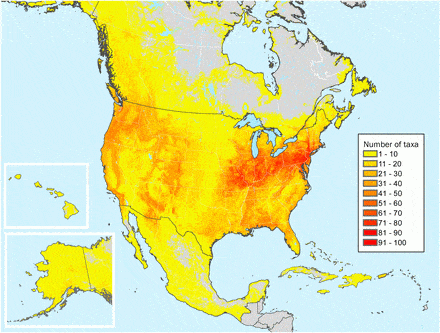
A new study in Proceedings of the National Academy of Sciences for the first time outlines how poorly protected wild plants native to the U.S. are. In fact, more than half of the 600 plants assessed in the study may be endangered in their natural habitats, while only 7% are well represented in conservation repositories such as public gene banks and botanical gardens.
“We don’t usually think of the United States or North America as a hotspot of globally important agricultural biodiversity, compared to regions like the Fertile Crescent, Southeast Asia, or Mesoamerica, where so many of the crops we grow originated,” says Colin Khoury, the study’s lead author and researcher at the Alliance of Bioversity International and CIAT. “But our research shows that there’s a stunning number of native plants that are, or could be, key to the future of agriculture.”
“We don’t usually think of the United States or North America as a hotspot of globally important agricultural biodiversity, compared to regions like the Fertile Crescent, Southeast Asia, or Mesoamerica, where so many of the crops we grow originated,” says Colin Khoury, the study’s lead author and researcher at the Alliance of Bioversity International and CIAT. “But our research shows that there’s a stunning number of native plants that are, or could be, key to the future of agriculture.”
“Continuing to find and use these traits could prove critical to food security and the sustainability of agriculture, both here in the U.S. and around the world, as climate change and natural resource limitations, such as water availability, worsen,” Khoury says. “But unless we take urgent action to better safeguard these native plants, many will probably disappear.”
Wild plants are constantly under pressure as their natural habitats are disturbed or destroyed, and as invasive species and climate change make their native homes more difficult to thrive in. Many crop wild relatives, such as wild peppers, are also harvested by people, presenting a unique challenge for conservationists to ensure both that locals have access to plants of cultural importance, and that the species survive for the long term.
Wild relatives that need urgent conservation include those of cereals, fibers, fruits, nuts, oils, pulses (such as beans), spices, sugar and vegetable crops. Collectively, these crops are worth at least $116 billion a year to U.S. producers, according to the USDA. Robust protection of these plants in conservation repositories would cost a tiny fraction of those proceeds.
Examples of crop wild relatives that are highly threatened include a salt-tolerant sunflower native to a few locations in New Mexico and Texas, a wild pumpkin occurring only in south-central Florida, and a wild rice inhabiting one small stretch of the San Marcos River in Texas.
Field Botanists Wanted
The work ahead is substantial. Scientists need to collect plants in the field, increase the capacity of conservation facilities to care for the species for the long term, and study the plants so that information on their potential to support agriculture is widely available. Dauntingly, this is needed against a backdrop of declining numbers of field botanists and other practitioners who are essential to this work.
“Reliable information is needed to minimize gaps in the conservation of crop wild relatives, which ultimately benefit all of society,” says Anne Frances, Lead Botanist at NatureServe and co-author of the research. “Completing and regularly updating our understanding of which plants are at highest risk of extinction is essential to prioritize and guide conservation action. This study takes a giant leap towards providing this essential information.”
Establishing new protected areas for the species, especially in rapidly urbanizing areas of the country, will be a huge challenge. Alternatively, taking advantage of existing protected areas and other open spaces where the plants grow can provide easier wins. In many places, simply ensuring land managers are aware of crop wild relatives on their lands would make great progress toward their conservation. In some areas of the country, the authors acknowledge, these wild plants are barely recognized, and may even be mistaken for weeds or invasive species.
Citizen Scientists, Too
Protecting and making sure that these useful plants are available to present and future generations requires not only conservation action but also raising awareness. Hobbyists, gardeners, and nature lovers of all ages can get in on the action. A good way to start is with a visit to one of the countries’ hundreds of botanical gardens, which in combination boast some 120 million visitors in the U.S. during a typical year.
Botanical gardens are ramping up their efforts to inform the public about crop wild relatives, which occur not only in the wilderness but also in local parks, neighborhoods, and peoples’ back yards. “Botanical gardens and other organizations interested in crop wild relatives could play a pivotal role in introducing these plants to people, communicating their value and plight, and better connecting the concepts of food security, agricultural livelihoods and services provided by nature for the public,” Khoury says.